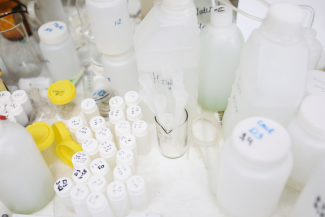Incident Lessons Learned - Faulty Wash Bottle
28 April 2023

Inspect containers regularly for leaks or deterioration
A university technologist was using a wash bottle (Eisco polyethylene 500mL) containing 70% ethanol and 30% water. When refilling the bottle, the technologist squeezed the bottle and noticed solution leaking around the cap, which was not sealing properly.
At the time, the spill was not a concern; however, the technologist had obtained this bottle from the department stores and knew that others might use these bottles for higher-risk substances. The bottle was not the usual type available for purchase and further investigation revealed that the problem was wider spread—another lab had also stopped using the bottle for the same reason.
The technologist didn’t stop there. They continued to inquire and determined that the reason the bottles were changed out was due to a supply issue and that defective bottles had been sent out as a replacement. It is not known if it was the specific lot or the type of bottle, but the technologist took steps to ensure anyone in their department could return the defective bottles and replace them for free. These proactive steps minimized the risk arising from skin and respiratory exposure to a solvent and the fire hazards associated with ethanol.
Culture of Care
This incident highlights a key objective of the university’s Culture of Care Safety Action Plan: to own our safety performance and that of others. The technologist could have corrected the issue for their own lab and moved on with their day, but this was not acceptable to them.
Instead, they took it upon themselves to identify the issue and to ensure that others who may be using these bottles, potentially with high-risk substances, were aware and had the opportunity to fix the issue before it occurred. This is an excellent example of how we can care for one another in the workplace.
Call to Action
Next time an incident or near miss occurs in your lab, ask yourself if others may also be at risk of the same thing happening to them. If the answer is yes, take action. This does not mean that you personally need to hunt down and determine every potential issue. Some examples of steps you could take include:
- Sharing the information with your department and/or faculty
- Sharing the information with your HSE Committee
- Reaching out to HSE if you feel the lessons learned from the incident or near miss should be shared university-wide.
For more information about incidents or near misses, visit the HSE website or contact hse.info@ualberta.ca.
The University of Alberta is committed to the safety, health and well-being of our faculty, staff and students. Every day, we advance this commitment to safety through the Culture of Care.
Related resources
- Incident Lessons Learned - Faulty Wash Bottle (Google Doc)
- Culture of Care Safety Action Plan
- Report an Incident webpage: information about what to report and link to reporting form


